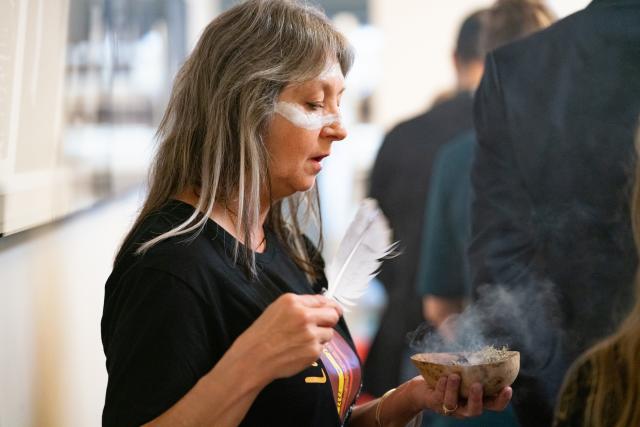
Sophie Conlon
The remains of a South East Aboriginal ancestor were returned from the United Kingdom to Australian soil in a ceremony that saw 18 First Nations ancestral remains returned to Australia.
The ancestors were held by two natural history museums in Britain, the Pitt Rivers Museum and Oxford University Museum of Natural History, and were obtained during the 19th century and early 1900s.
South East Aboriginal Focus Group (SEAFG) co-chair Bunganditj and Meintangk woman Robyn Campbell also chief executive officer of Burrandies Aboriginal Corporation attended and performed a Traditional Smoking Ceremony at Oxford University to create a safe passage back home for her ancestor.
The SEAFG, who are represented by traditional owner groups of the South East, have been managing cultural heritage on the Limestone Coast for 18 years, and Ms Campbell said talks of bringing their ancestor home began through the International Repatriation Program before Covid hit which delayed the return.
“Discussions continued with the SEAFG once Covid restrictions were lifted and I was nominated by the Elders to attend and represent the SE First Nations People, ” she said.
The emerging Elder said participating and performing the Smoking Ceremony and bringing her ancestor home was a truly unforgettable experience.
“It was very emotional for me and quite rewarding at the same time,” she said.
“The removal of our Old People has brought deep sadness and worry. Our ancestors’ removal to an alien museum environment has been a source of great distress and shame.
“The return of our Old People is to fulfil our cultural obligations and we hope it will contribute to our recovery as First Nations People.”
About 60 people attended the handover ceremony, including Australian acting high commissioner, Lynette Wood; the first secretary economic at the Australian High Commission, Nick Williams; and assistant director for Indigenous repatriation for the Office for the Arts, Wendy Dalitz; as well as head of gardens, libraries and museums at University of Oxford, Professor Richard Ovenden; director of the Pitt Rivers Museum, Professor Laura Van Broekhoven; and director of Oxford University Museum of Natural History, Professor Paul Smith.
During the handover, Ms Campbell spoke about what it meant to bring the ancestors back to their rightful homes.
“It was a very emotional experience for me,” she said.
“It was such an honour and privilege to bring our ancestor home and I am very grateful.”
The remains are believed to belong to an elderly Bunganditj woman, who was taken from Lake Hawdon and later donated to the Pitt Rivers Museum by a collector in 1900.
Of the 18 ancestors returned home, six were from South Australia, but only the Bunganditj ancestor could be culturally identified.
The 17 other ancestors were placed in the stewardship of the Australian Government, while further research could be undertaken to determine their traditional First Nations custodians.
Ms Campbell arrived in Adelaide with her ancestor on Monday, November 14, and said her ancestor would be temporarily cared for by the South Australian Museum with five other ancestors from various other First Nations communities within South Australia.
“I was greeted by Uncle Moogy Sumner and Anna Russo from the SA Museum and followed the ancestors to their temporary resting place,” she said.
The Bunganditj ancestor will remain in Adelaide until further plans to lay her to rest are made.
“We still need to have further consultations with the South East First Nations people and we’re going to look at plans for a ceremony probably early next year,” Ms Campbell said.
“This is the first step, our ancestor has been brought back.”
Federal Minister for the Arts, Tony Burke said the government was committed to bringing home ancestors through the Indigenous Repatriation Program.
“More than 1,660 ancestors have now been repatriated from overseas collecting institutions and private holders to date – and while this is a significant effort contributing to healing and justice for First Nations communities, we remain committed to supporting future returns, as part of our ongoing journey of reconciliation,” he said.
“Repatriation of First Nations ancestors is an important part of Australia’s ongoing journey of healing and reconciliation.”
Federal Minister for Indigenous Australians Linda Burney said repatriation honours the deep cultural and emotional significance of returning ancestors to their traditional lands.
“It is in the return of ancestors that dignity can be recognised and respected,” she said.
“It restores their rightful place as Elders, mothers, fathers, grandmothers, grandfathers, uncles, aunts, brothers and sisters and acknowledges the unbreakable bond of customary obligation and traditional practices between the living, the land and the dead.
“The repatriations will allow communities to carry out their cultural obligations in returning their ancestors to Country.”
Director of the Pitt Rivers Museum Professor Laura Van Broekhoven said returning the remains to Australia would begin a new chapter in the museum’s history.
“For institutions like ours, that are so deeply rooted in coloniality, events such as this begin a new chapter of museum history, joining an Indigenous-led process that works towards healing,” she said.
“We are grateful to Australia’s Aboriginal and Torres Strait Islanders for their leadership in this process and happy that their ancestors are finally able to return home.”
While this return took five years, in 2017 the Pitt Rivers Museum returned remains to New Zealand, Aotearoa which took 15 years to complete, Ms Van Broekhoven said the slowness was frustrating but had hope for future repatriations.
“My hope for the future remains that we’ll learn from these returns to streamline processes, and ensure that next time, we can return ancestors as soon as community members have requested them to be returned,” she said.








